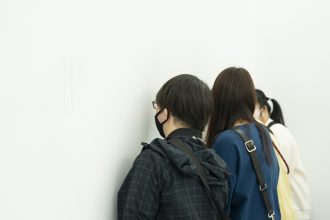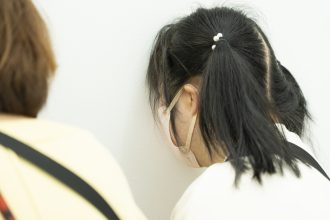Inspired by the Netherlands, the “Inspiration Tour” is an appreciation and creation program that takes diverse participants to museums, where they encounter diverse artistic expressions and events through surprise and dialogue, and create opportunities for inspiration to lead to new expressions of their own.
A new appreciation experience to recognize one’s sensation with one’s body.
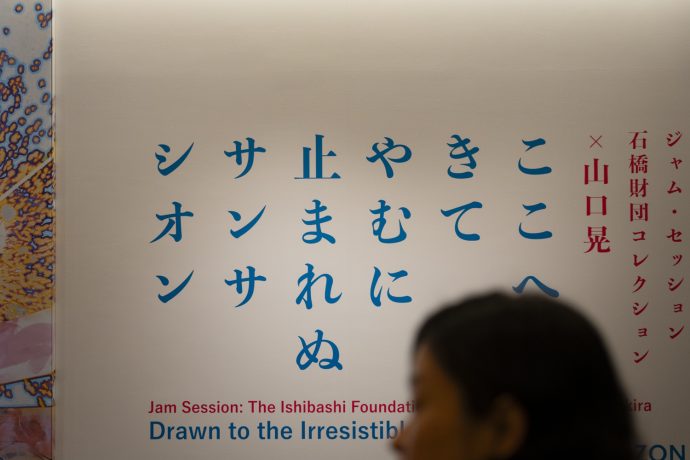
The “Inspiration Tour,” one of CAT’s initiatives, was held on October 28, 2023. This is a tour in which members with disabilities visit museums to gain new inspiration and discoveries through dialogue. Nine members of atelier A and nine facilitators visited the Artizon Museum. The group was divided into small groups to view Jam Session: The Ishibashi Foundation Collection x Yamaguchi Akira Drawn to the Irresistible Sensation, which is the fourth installment of a series of “Jam Session” in which contemporary artists and the Ishibashi Foundation Collection collaborate.
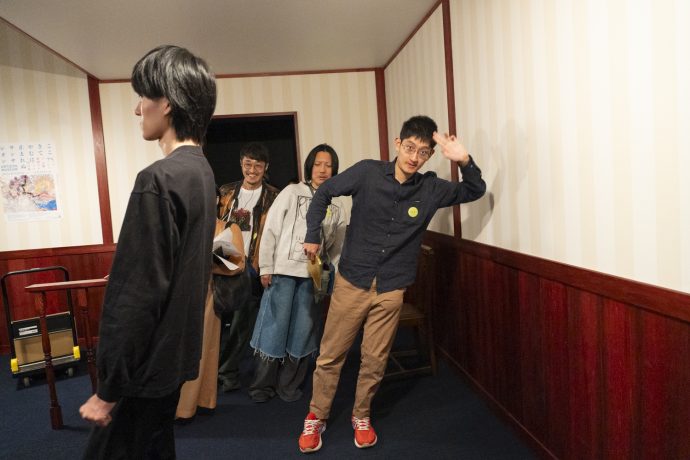
The word “sensation” appears to mean a feeling that precedes emotion. The exhibition starts with an installation that makes visitors physically aware of their own sensations. The members of atelier A were welcomed to a space named 《Thou shalt err by reason of experience》. This is a space that shakes the senses that we usually take for granted. The entire room was tilted, making it difficult to even stand up straight, and the members were each surprised, a little dazed, and enjoyed taking pictures without worrying about gravity at all. Each of them appeared to be capturing their own sensation, at his or her own rhythm.

Jam Session: Cézanne x Akira Yamaguchi – how did the children respond?
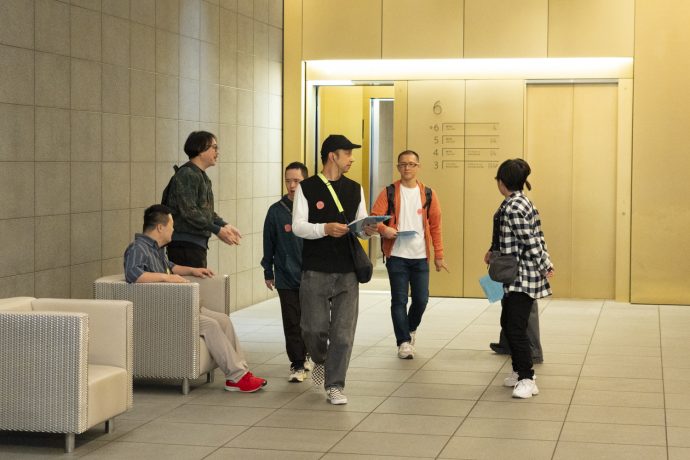
This time, as his jam session partners, Yamaguchi Akira-san chose Cézanne, the father of modern painting, and Sesshu, a painter and monk known as a great master of Japanese ink painting. The members proceeded to the exhibition room that displayed the works of art and interpretations developed by Yamaguchi-san that takes reference to the works of these painters. Koki-san, who likes to transcribe the poem “Ame ni mo Makezu (‘Be not Defeated by the Rain’)” by Kenji Miyazawa when he is at atelier A, was intrigued by Yamaguchi-san’s explanatory text about Cézanne and Sesshu.
Masakazu-san, in viewing Paul Cézanne’s “Mount Sainte-Victoire and Château Noir”, saw dynamic clouds as a tornado, and named the work as “Mansion in the Storm” and then spun a story inspired by the painting, about “a restaurant on the mountain near Spain where you can eat well balanced food.”
In the section showing the series of bird’s-eye views of cities drawn by combining the techniques of Yamato-e (a style of Japanese painting) and Western painting, there were members imagining what time period, what kind of place, what can be seen, and what the people living in the houses depicted on the map were doing. For example, the part of the map with the word “classified” drawn on it, Yoichiro-san and Masakazu-san guessed “Isn’t that Sakamoto-san’s house?”, mentioning the name of a person who always takes pictures at atelier A. They continued chatting that the colored areas are “where famous people live.”
It’s as if I took a time machine, arrived at the destination, and history has changed.
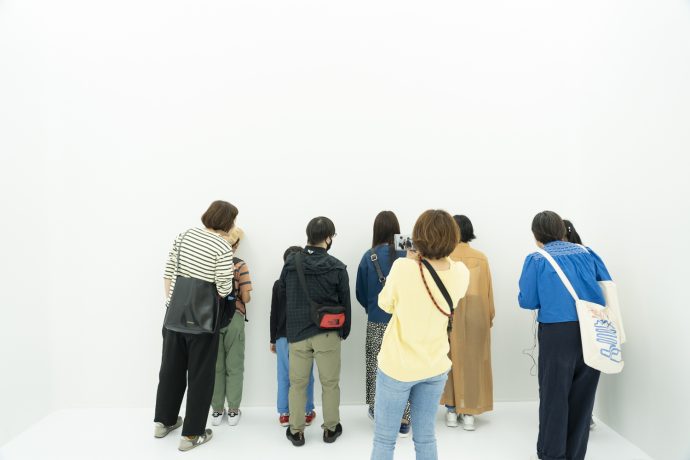
Proceeding to the “Mosquito Room,” a pure white space, a new trick was waiting for members: when they were in the all-white space, they became aware of “muscae volitantes”, a phenomenon in which they could see shadows that looked like flying mosquitoes. The members who stayed for a few minutes got excited saying: “I saw the shape of a hiragana letter ‘no(の)’! It’s going from the bottom toward the top!” and “I saw something small and black!”
Moving into the “Outline Anagram” room, where Sesshu’s landscape paintings (sansui-ga) became three-dimensional, the earlier eye movement exercise contributed to the effect, giving a greater sense of depth and even dynamism to members. In front of the 3D landscape painting, Shoma-san said, “This is a ninja zone. It’s like the melody of the Pink Panther is playing when I close my eyes. It’s as if I took a time machine, arrived at the destination, and history has changed.”
Haruki-san paid attention to the materials, appearing excited and saying “Everything is made of paper. I want to go inside. It looks like it’s moving!” In the spaces in which the works were placed, Yukari-san described each space as a “slanted world,” a “pure white world,” and a “pure dark world”, capturing in color shades. She also paid attention to the structure of the exhibit. She was experiencing not only the work itself, but also the whole architecture.
There is no correct answer in how to view art – this is a place to exchange inspiration.
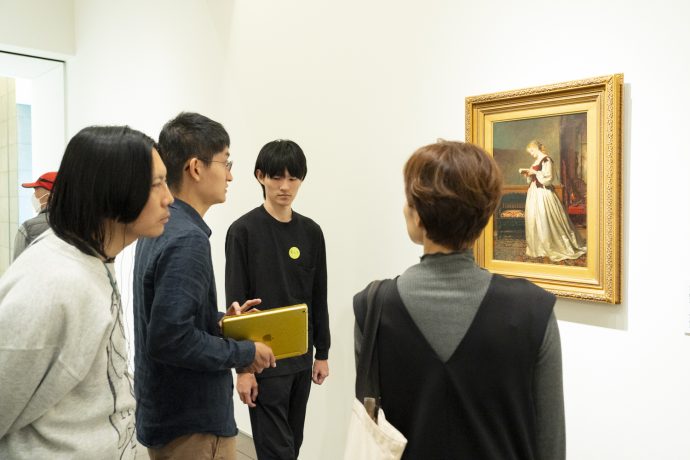
Each member has his or her own speed of appreciation as well as whether or not to put into words the sensation of seeing works of art. While stopping and affirming each work one by one, Yuui-san expands the story behind it in his mind, saying, “this work has such and such a legend …….”
On the other hand, Ryunosuke-san, while advancing at a fast pace, stopped in front of a painting that caught his attention and took his time to appreciate it. When asked what he liked about Okada Saburosuke’s “Girl and a Rose,” he pointed to the soft texture of the long skirt.
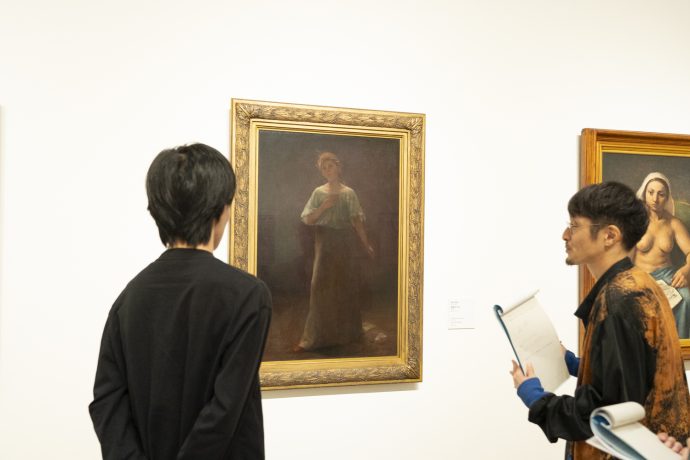
Throughout the special and permanent exhibitions, it was Tsuyoshi-san who, from a collector’s perspective, enjoyed “finding favorite paintings to hang at home and taking pictures of them.” With the goal of finding seven of his favorite paintings, he circled the two exhibition rooms twice and, after much deliberation, ended up photographing ten of his favorites, three more than he had anticipated.
There is no correct answer on how to view art. Even if you want to follow your inner guidance and sense and drift with your emotions, when you step into a museum, you will find yourself having a one-track mind and trying to find a single answer or trying to cleverly verbalize art. That is why I was surprised and enriched by the imagination and freedom of expression of the Inspiration Tour members as they encountered art. Not only the artists, but also the members there were experiencing art with their bodies, in sessions with the spaces, the works, and the people they were viewing with. Witnessing their reaction, the viewing time gave me further inspiration and energy.
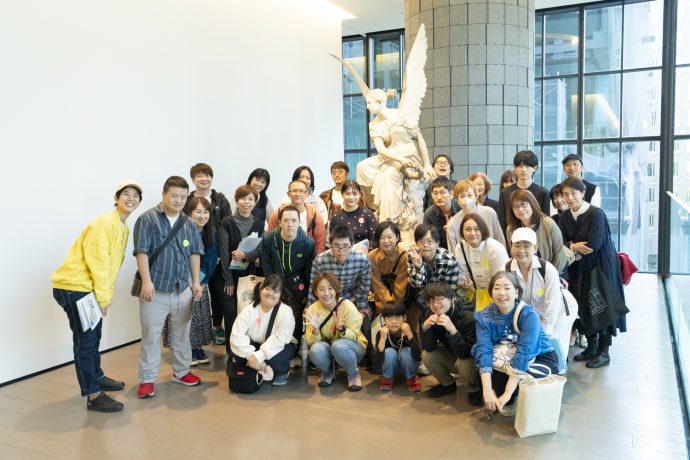
Text:Tomoko Ogawa Photo: Isamu Sakamoto
Excerpts of the Remarks Made by Children and Youths Participating in The Inspiration Tour
Paul CÉZANNE《Mont Sainte-Victoire and Château Noir》
“It’s bluish, there’s also green – this is probably a mansion in the storm.”
(Where is this mountain?) “Near Spain.”
(What kind of people live there?) “Climbing a mountain.”
“This is the first of (my favorite) piece” (the member asks the facilitator to take a photo)Paul CÉZANNE《Self-Portrait with a Hat》
“It looks like a funeral.” (“Whose?”) ‘My grandfather’s.” (This man painted the picture of the mountain next to this piece) ‘Maybe this (mountain) is what he painted before he died.’ “(Cézanne, in his painting) painted Van Gogh’s story, this man is his rival.”
“The desk is struggling.”
YAMAGUCHI Akira《Horseback Archery》(Who is this big guy?) “Momotaro”, “Sagittarius”
(Who’s that in the back?) “Grandma”
(What is grandma doing?) “I think she’s sleeping. She’s either sleeping or looking at something.”
(What are you looking at?)” Tokyo Metropolitan Government Building”Paul CÉZANNE《Bowl and Milk-Jug》
“I want to drink milk from a white bowl.”
“This is (my favorite) second piece of work.”
YAMAGUCHI Akira《Outline Anagram》“Got on a time machine and arrived in the Meiji Era. But changing history will be a problem as I would disappear.”
YAMAGUCHI Akira《Shuto !! Nihonbashi》 (MORNING two published by Kodansha)
“Isn’t that the Tokyo Station? There is a theory that Nihonbashi was here at first, but it collapsed and then it became Tokyo Station from here.”
(Pointing to a boy) “He looks like the older brother in ‘Grave of the Fireflies.’”
In the Showa era, it will be the year 33! Showa is the generation of my father and mother. From the Showa to the Heisei era, I was born, and I have grown up.Unknown 《The area in and around the Kyoto city》
(What era is this?) “I think it is the Edo period. Ieyasu keeping the peace in a castle, holding a sword. For example, a battle starts in the middle of Chiba and Tokyo. There are lords in that room, and they talk to each other, and from there, they would have retainers.”
“I like cows. They are cute. I love cows.”Wassily KANDINSKY《Self-Illuminating》
“This is my grandmother.” (Why?)
“The red is already in this work. I saw her face the moment I saw it.”
There’s an R, there’s a C, there are three O’s”, “it’s like a black cake.”
This is “=”, the result of multiplication (in mathematics).”Henri MATISSE《Odalisque》
“There is some kind of legend about a man who painted a picture in the forest in connection with a golden frame.”
“There is some profound legend about the sunflowers and the fruit in the book that she is reading (in the painting).”
“The bigger the picture, the more flamboyant it is, the rarer the legend.”
Comments from the Parents
“When I go to a museum with my children, I always force them to appreciate the exhibits quietly so as not to disturb others. This time, they were able to enjoy the artworks while talking about what they felt on the spot, so I think they were able to relax and enjoy themselves.”
“They very much enjoyed the museum tour. They were happy to see the artworks while talking with the group. They said ‘I enjoyed my second visit to the Artizon Museum. I want to go again!’”
“With other organizations, I think they often make the participants act quietly and collectively, which makes them nervous, with the experience becoming less enjoyable and emotional. I feel that activities like this one teach them the true joy of art appreciation.”
“I hope that the Inspiration Tour staff will continue to listen to the participants’ stories and help them to be generous by spending fun time with them.”
“They said they very much enjoyed it!”
I felt that Ryu received a lot from looking at the paintings. There is a certain emotion that is conveyed not through words, but by seeing Ryu himself looking at the paintings. I feel a bit frustrated not being able to convey this well in words.
Watching him by the side, I became very interested in how Ryu felt about the world. I personally got the impression that Ryu was directly in touch with sensations outside of the conceptual information that we usually exchange. It was a very good experience. I would like to cherish, within myself, the atmosphere that was created between Ryu and the paintings that day.
The work that most interested Koki-kun was Yoshida Hiroshi’s 《Rapid Stream》. The moment he saw it, he said, "I love this!” I asked him, "What do you like about this painting?” He replied, "I like the way the water flowing between the hard, rugged rocks of the river look pale pink, as it gives a gentle impression. “ I was surprised to hear such a delicate and wonderful answer, which I could not have imagined from my impression of the work, and I was again interested in how Koki-kun sees the many works in the museum. He went back to see this work after first viewing it, and I was convinced that there was something about 《Rapid Stream》 that moved him in a way that the other works did not.
Yoko Akaogi (Facilitator / CO-Director, atelier A)There was a lot of stimulation and new discoveries. I was again surprised at how everyone's sensors were working, not only for the artworks, but for the entire museum. I was surprised to see that the resting chairs and the holes in the walls of the museum (not scratches, but something like a light fixture – a part of the museum's original structure) became something enjoyable and something to want to experience. By sharing and exchanging differences, I think they were also able to learn that each person has their own way of feeling, as well as experience the fun of new discoveries through the sensation of others. The fun discovery this time was that through the children's sensation, I was able to “experience the museum through all five senses, including the artworks, and fully relish the ways of looking at the world.” I was amazed at how they saw things in ways I would never have imagined on my own!
Tomoko Nishida (Facilitator / Mental Health Social Worker)Masazu-san often shared his intuitive impressions in words, and it gave me a warm feeling to see how he was imagining episodes and memories, especially of his close family members, from some kind of inspiration he found in the expression of artworks. He seemed to immediately connect the impressions from the paintings to his parents, grandfathers, grandmothers, and others. On Henri Matisse's 《Collioure,》he mentioned "summer watermelon splitting,” sharing that the work reminded him of early summer festivals, perhaps because of the soft, gentle colors and the bright atmosphere. There were two images that overlapped in my mind - the scene imagined by Masakazu, who said Collioure looked fun and that he would love to visit, and the scene of the painter, Matisse, watching people talking to each other in the pleasant weather in the small fishing village where he stayed with his friends at the time. I had a blissful moment, feeling the connection that transcended time and space.
Rika Fujii (Project Manager, Arts Initiative Tokyo / AIT)Co-planning: Tetsu Akaogi (atelier A)
Facilitator: Taku Yokosuka, Yoko Akaogi, Mashu Oki, Yosuke Yamaguchi, Saki Kato, Tomoko Nishida
Supported by SBI Shinsei Bank Group
Photographer: Isamu Sakamoto
Writer: Tomoko Ogawa
Special Thanks Everyone who participated the workshop, Ryota Nagai (Roland)
Date: Saturday, October 28 2024
Venue: Artizon Museum (Tokyo)
Organized by Bunkacho and Arts Initiative Tokyo
Cooperated by atelier A
-
Tomoko OgawaBorn in Tokyo in 1982. He writes interviews, film reviews, contributes columns, and translates mainly for magazines. Co-author of "100 ROMANTIC MOVIES FOR ALL" (Okura Publishing Co., Ltd.).
-
About ExhibitionJam Session: The Ishibashi Foundation Collection x Yamaguchi Akira Drawn to the Irresistible Sensation
Exhibition period: 9 September [Sat] - 19 November [Sun], 2023
Opening hours: 10:00 – 18:00 (until 20:00 on Fridays except November 3) *Last entry 30 minutes before closing.
Closed: Mondays (except September 18, October 9), September 19, October 10
Organizer: Artizon Museum, Ishibashi Foundation
Venue : Artizon Museum 6F Gallery
Concurrent Exhibitions: From the Scene of Creation ―Artists’ Archives in Films and Photographs (5F Gallery)
Selections from the Ishibashi Foundation Collection Special Section Women Reading(4F Gallery)






